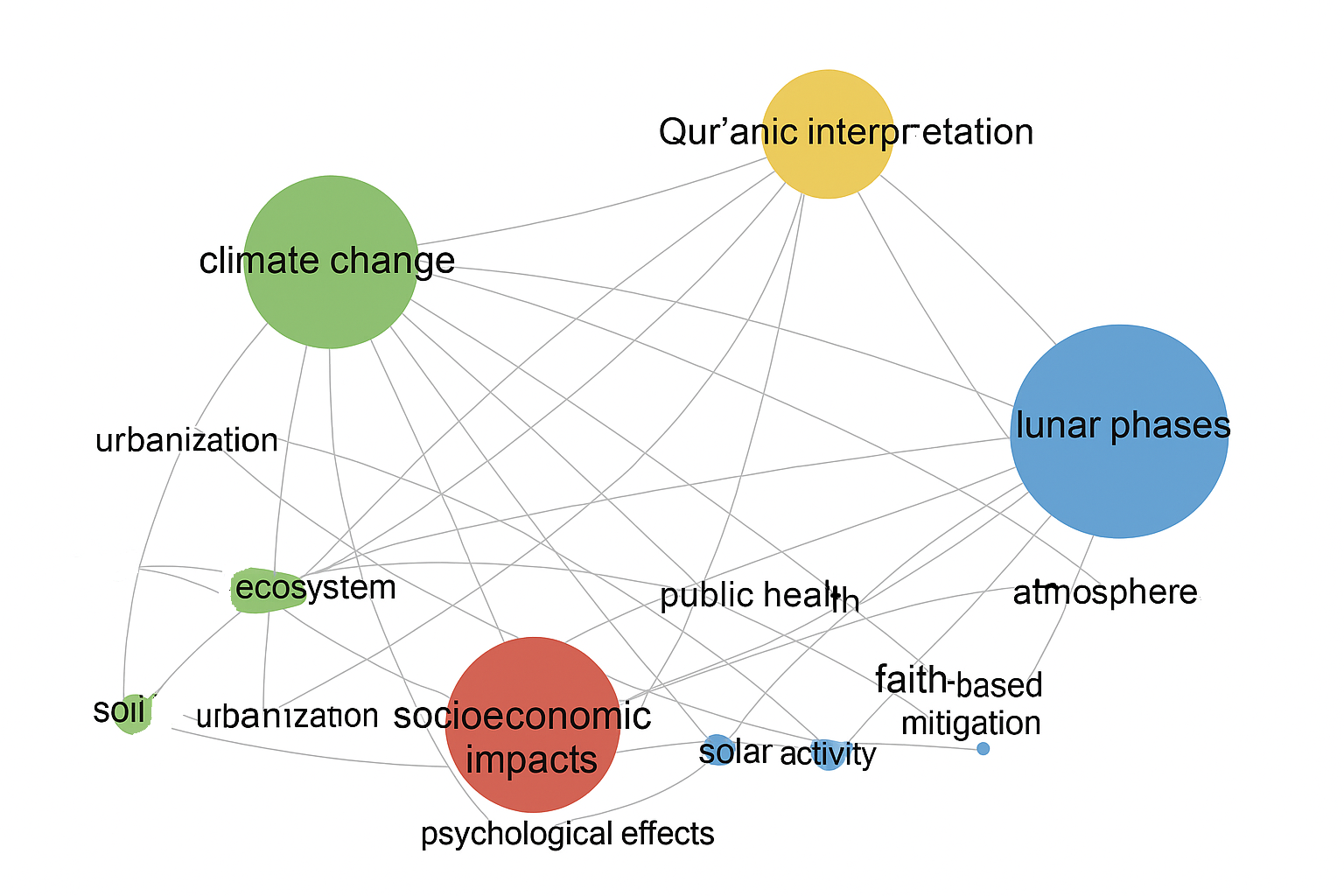Exploring Flood Dynamics: Integrating Environmental, Social, Astronomical and Islamic Perspectives
Abstract
 Abstract Views: 0
Abstract Views: 0
Floods are a recurring natural disaster with profound implications for human livelihoods, infrastructure, and the environment. This study critically examines existing literature to identify the primary causes, impacts, and mitigation strategies associated with flash floods, integrating insights from Islamic perspectives and exploring their relationship with astronomical phenomena, a relatively understudied area. Despite substantial research on hydrological and urban factors, limited attention has been given to the interplay between astronomical elements, such as lunar phases and solar activity, and flash flood occurrences. This gap underscores the need for a multidisciplinary approach\ to understand these complex phenomena. The study employs a qualitative methodology involving systematic literature review and content analysis. Key findings highlight heavy rainfall, unplanned urbanization, inadequate drainage systems, and individual behaviors as major contributors to floods. Furthermore, the study identifies significant socioeconomic and environmental impacts, including property damage, disruption of livelihoods, and psychosocial effects. Proposed mitigation strategies emphasize improved drainage infrastructure, public awareness campaigns, and the integration of Islamic principles for sustainable disaster management. This research contributes to bridging critical knowledge gaps by suggesting future studies on the role of astronomical factors in flood prediction and advocating for faith-based approaches to environmental stewardship. The findings aim to inform policymakers, urban planners, and environmentalists about developing holistic and sustainable solutions.
Downloads
References
Ab. Wahid, Abdul Muhaimin., Zaiwannizar Zainal Abidin, Mohd Esham Mamat, Noraini Md Zain, Mohammad Nasharudine Shuib, and Mohd Nazri Abdullah. “An Analysis of Defects on Floating Mosque in Perak.” International Journal of Business and Technology Management 5, no. S3 (2023): 12–19.
Abid, Sheikh Kamran., Noralfishah Sulaiman, Ahmed M Al-Wathinani, and Krzysztof Goniewicz. “Community-Based Flood Mitigation in Malaysia: Enhancing Public Participation and Policy Effectiveness for Sustainable Resilience.” Journal of Global Health 20, no. 14 (2024): 04290, https://doi.org/10.7189/jogh.14.04290.
Acosta-España, Jaime David., Daniel Romero-Alvarez, Camila Luna, and Alfonso J Rodriguez-Morales. “Infectious Disease Outbreaks in the Wake of Natural Flood Disasters: Global Patterns and Local Implications.” Infez Med 32, no. 4 (2024): 451–462, https://doi.org/10.53854/liim-3204-4.
Ali, Abdul Halim. Ensiklopedia Pendidikan Sains dalam Al-Qurʾān [Encyclopedia of Science Education in the Qurʾān]. Kuala Lumpur: Emedia Publication, 2005.
Angelakis, Andreas N., Andrea G. Capodaglio, Mohammad Valipour, Jens Krasilnikoff, Abdelkader T. Ahmed, Laila Mandi, Vasileios A. Tzanakakis, Alper Baba, Rohitashw Kumar, Xiaoyun Zheng, Zhang Min., Mooyoung Han, Bashiru Turay, Esra Bilgiç, and Nicholas Dercas. “Evolution of Floods: From Ancient Times to the Present Times (ca 7600 BC to the Present) and the Future.” Land 12, no. 6 (2023): 1211, https://doi.org/10.3390/land12061211.
Anuar, Nur Balqis., and Sulzakimin Mohamed. “Kesan Pembinaan Bandar Baru Tunjong, Kota Bharu, Kelantan Terhadap Kawasan Petempatan Penduduk (Kesan Banjir Kilat) [Impact of the Construction of Bandar Baru Tunjong, Kota Bharu, Kelantan on Residential Areas (Impact of Flash Floods)].” Research in Management of Technology and Business 2, no. 1 (2021): 668–677.
Arshad, Siti Hasniza Muhammad., Asnor Muizan Ishak, Nurfashareena Muhamad, and Joy Jacqueline Pereira. “Penilaian Keberkesanan Terowong SMART Kuala Lumpur dalam Menghalang Banjir Kilat [Evaluation of the Effectiveness of the SMART Tunnel in Kuala Lumpur in Preventing Flash Floods].” Geografia: Malaysian Journal of Society and Space 16, no. 3 (2020): 184–200.
Botzen, W. J. Wouter., Olivier Deschenes and Mark Sanders. “The Economic Impacts of Natural Disasters: A Review of Models and Empirical Studies.” Review of Environmental Economics and Policy 13, no. 2 (2019): 167–188.
Bult, Sterre V., Dewi Le Bars, Ivan D. Haigh, and Theo Gerkema. “The Effect of the 18.6‐Year Lunar Nodal Cycle on Steric Sea Level Changes.” Geophysical Research Letters 51, (2024): e2023GL106563,
Buslima, F.S., R. Omar, Tajul Anuar Jamaluddin, and Hairin Taha. “Flood and Flash Flood Geo-Hazards in Malaysia.” International Journal of Engineering and Technology 7, no. 4 (2018): 760–764, https://doi.org/10.14419/IJET.V7I4.35.23103.
D’Ayala, Dina., Kai Wang, Yuan Yan, Helen Smith, Ashleigh Massam, Valeriya Filipova, and Joy Jacqueline Pereira. “Flood Vulnerability and Risk Assessment of Urban Traditional Buildings in A Heritage District of Kuala Lumpur, Malaysia.” Natural Hazards and Earth System Sciences 20, (2020): 2221–2241, https://doi.org/10.5194/nhess-20-2221-2020.
European Union. “Directive 2007/60/EC of the European Parliament and of the Council of 23 October 2007 on the Assessment and Management of Flood Risks.” Official Journal of the European Union L288/27 (2007).
Hakim, Dimara Kusuma., Rahmat Gernowo and Anang Widhi Nirwansyah. “Flood Prediction with Time Series Data Mining: Systematic Review.” Natural Hazards Research 4, no. 2 (2024): 194–220, https://doi.org/10.1016/j.nhres.2023.10.001.
Hashim, Noorazuan Md., Zaini Sakawi, Kouk Choy Lam, Mokhtar Jaafar, Rosniza Aznie Che Rose and Nor Hasyifa Ahmad. “Penentuan Model Adaptasi Terhadap Kemudahterancaman Kenaikan Aras Laut di Selangor, Malaysia [Determination of an Adaptation Model to Sea Level Rise Vulnerability in Selangor, Malaysia].” e-BANGI Jurnal Sains Sosial dan Kemanusiaan 16, no. 4 (2019): 1–15.
Hassan, Munirah Che., Sharifah Meryam Shareh Musa, Rozlin Zainal, and Narimah Kasim. “Kajian Permasalahan Pembinaan Sistem Saliran Yang Menjadi Punca Kepada Masalah Banjir di Kawasan Perumahan [A Study on Drainage System Construction Issues as a Cause of Flooding Problems in Residential Areas].” Research in Management of Technology and Business 1, no.1 (2020): 588–605.
Heanoy, Eamin Z., and Norman R. Brown. “Impact of Natural Disasters on Mental Health: Evidence and Implications.” Healthcare 12, no. 18 (2024): 1812, https://doi.org/10.3390/healthcare12181812.
Husin, Mohd Azrin., Aummil Nadira Mohamad, and Ahmad Muhyuddin Hassan. “Tragedi Banjir Kilat di Kuala Lumpur: Punca dan Penyelesaiannya [Flash Flood Tragedy in Kuala Lumpur: Causes and Solutions].” Prosiding Seminar Falsafah Sains dan Ketamadunan 4, no. 2 (2022): 287–302.
Ismail, Mohd Luqman., Sharifah Meryam and Shareh Musa. “Study on the Implementation of Drainage System at Universiti Tun Hussein Onn Malaysia (UTHM).” Journal of Techno-Social 12, no. 2 (2021): 12–20.
Jafar, Adi., Nordin Sakke, Mohammad Tahir Mapa, Azali Saudi, Diana Hassan, and Fionna George. “The Effect of Monsoon Towards Flood Hazard: Case Study of Flood Plains in Beaufort, Sabah.” Jurnal Kinabalu 26, no. 2 (2020): 165–182.
Kundzewicz, Zbigniew W., Shinjiro Kanae, Sonia I. Seneviratne, John Handmer, Neville Nicholls, Pascal Peduzzi, Reinhard Mechler, Laurens M. Bouwer, Nigel Arnell, Katharine Mach, Robert Muir-Wood, G. Robert Brakenridge, Wolfgang Kron, Gerardo Benito, Yasushi Honda, and Kiyoshi Takahashi. “Flood Risk and Climate Change: Global and Regional Perspectives.” Hydrological Sciences Journal 59, no. 1 (2013): 1–28.
Lamond, Jessica Elizabeth., Namrata Bhattacharya-Mis and Robin Bloch. “The Role of Solid Waste Management as a Response to Urban Flood Risk in Developing Countries, A Case Study Analysis.” WIT Transactions on Ecology and The Environment 159, (2012): 193–204, https://doi.org/10.2495/FRIAR120161.
Mansor, Nur Fathira Aimi., Nik Norliati Fitri Md Nor, Nur Rafidah Asyikin Idris, Siti Masayu Rosliah Abdul Rashid, Izham Mohamad Yusoff, and Ricky Anak Kemarau. “Flood Disaster and Impact on Residents: Case Study in Kedah.” Geografi 11, no. 1 (2023): 44–67.
Md Akhir, Nur Hafizah., Azlinda Azman, and Noremy Md Akhir. “Impact of Disaster on Volunteers’ Health and Safety.” Jurnal Psikologi Malaysia 34, no. 2 (2020): 93–104.
Meseka, Tabitha. “The Impact of Flood Disaster Response Strategies on Health Outcomes: A Study of Western Equatoraia.” International Journal of Dentistry, Diabetes, Endocrinology and Oral Hygiene 6, no. 1 (2024): 40–56, https://doi.org/10.37745/ijddeoh.18/vol6n14056.
Al-Mubarakpuri, Sheikh Safiur Rahman. Tafsir Ibn Kathir. Lebanon: Maktabat Dar al-Salam, 2003.
Muhamad, Nurfashareena., Choun-Sian Lim, Mohammad Imam Hasan Reza, and Joy Jacqueline Pereira. “Keperluan Peta Kerentanan Bencana Sebagai Input dalam Pengurusan Guna Tanah: Kajian Kes Universiti Kebangsaan Malaysia [The Need for Disaster Vulnerability Maps as Input in Land Use Management: A Case Study at Universiti Kebangsaan Malaysia].” Sains Malaysiana 48, no. 1 (2019): 33–43, https://doi.org/10.17576/JSM-2019-4801-05.
Muzamil, Syed Ahmad Hakim Syed, Noor Yasmin Zainun, Nadiatul Nazleen Ajman, Noralfishah Sulaiman, Khahro Shabir Hussain, Munzilah Md. Rohani, Mohd Saifullizan Mohd Bukari, and Hilton Ahmad. “Proposed Framework for the Flood Disaster Management Cycle in Malaysia.” Sustainability 14, (2022): 4088, https://doi.org/10.3390/su14074088.
Al-Najjar, Zaghlul. Tafsir al-Ayat al-Kawniyyah fi al-Karim. Mesir: Maktabah Syuruq al-Dawliyyah, 2010.
Nooryati. Bencana Banjir Kilat di Selangor, Faktor Perubahan Iklim?[Flash Flood Disasters in Selangor: Climate Change Factors?]. Serdang: Institut Pengajian Sains Sosial Universiti Putra Malaysia, 2022.
Purohit, Sanju. Climate Chronicles: Unveiling the Past, Present, and Future of Global Sustainability. Jaipur: The Global Publishers & Distributors, 2024.
Ramli, Hanis Syazwani, Haryati Shafii, Haidaliza Masram, Seow Ta Wee, Norliana Sarpin, and Mohd Hairy Ibrahim. 2023. “Isu ‘Poket Development’ Membawa Kepada Masalah Banjir Kilat Di Kawasan Pinggir Bandar [The Issue of ‘Pocket Development’ Leading to Flash Flood Problems in Suburban Areas].” Research in Management of Technology and Business 4, no.1 (2023): 1185–1202.
Razip, Nursyafika Mohamad., Sharifah Meryam Shareh Musa, Rozlin Zainal, Hamidun Mohd Noh and Narimah Kasim. “Kajian Pembinaan Sistem Saliran Mesra Alam di Kawasan Pembinaan Baharu [A Study on the Construction of Eco-Friendly Drainage Systems in New Development Areas].” Research in Management of Technology and Business 2, no. 2 (2021): 523–538.
Rijal, Madhab., Pingping Luo, Binaya Kumar Mishra, Meimei Zhou, and Xiaohui Wang. “Global Systematical and Comprehensive Overview of Mountainous Flood Risk Under Climate Change and Human Activities.” Science of The Total Environment 941, (2024): 173672, https://doi.org/10.1016/j.scitotenv.2024.173672.
Ruslan, Muhammad Akmal Ilham Ahmad., Norliana Sarpin, and Seow Ta Wee, Sulzakimin Mohamed & Haryati Shafii. “Penambahbaikan Sistem Perparitan Yang Menyebabkan Banjir Kilat di Jalan Kluang, Batu Pahat, Johor [Improvements to the Drainage System Causing Flash Floods in Jalan Kluang, Batu Pahat, Johor].” Research in Management of Technology and Business 4, no. 1 (2023): 1129–1142.
Safiah Yusmah, M.Y., L. J. Bracken, Z. Sahdan, H. Norhaslina, M.D. Melasutra, A. Ghaffarianhoseini, S. Sumiliana, and A.S. Shereen Farisha. “Understanding Urban Flood Vulnerability and Resilience: A Case Study of Kuantan, Pahang, Malaysia.” Natural Hazards: Journal of the International Society for the Prevention and Mitigation of Natural Hazards 101, no. 2 (2020): 551–571, https://doi.org/10.1007/s11069-020-03885-1.
Safiai, Mohd Hafiz, Salmah Abu Hasan, Mohd Saifullah Dimyati, Ahmad Ibrahim Azam, Ezad Azraai Jamsari, and Wilfred De Graaf. “The Influence and Adaptation of Observatories in Islamic Civilization: A Case of Malaysia.” Journal of Al-Tamaddun 19, no. 1 (2024): 75–91, https://doi.org/10.22452/JAT.vol19no1.6.
Safiai, Mohd Hafiz. “Enacting Space Law in Malaysia to Transfer Knowledge About Outer Space Engineering and Technology.” International Journal of Engineering Trends and Technology 72, no. 6 (2024): 228–237, https://doi.org/10.14445/22315381/IJETT-V72I6P123.
Saleh, Azlan., Ali Yuzir, and Nuridah Sabtu. “Flash Flood Susceptibility Mapping of Sungai Pinang Catchment Using Frequency Ratio.” Sains Malaysiana 51, no. 1 (2022): 51–65.
Shah, Syed Muzzamil Hussain., Zahiraniza Mustaffa, and Khamaruzaman Wan Yusof. “Disasters Worldwide and Floods in the Malaysian Region: A Brief Review.” Indian Journal of Science and Technology 10, no. 2 (2017): 1–9, https://doi.org/10.17485/ijst/2017/v10i2/110385.
Sharma, Shashikant Nishant, and D. Dauda Ayuba. Nature Based Solutions to Prevent Urban Flooding. New Delhi: Edupedia Publications, 2024.
Singh, Harman, Miriam Nielsen, and Helen Greatrex. “Causes, Impacts, and Mitigation Strategies of Urban Pluvial Floods in India: A Systematic Review.” International Journal of Disaster Risk Reduction 93, (2023): 103751, https://doi.org/10.1016/j.ijdrr.2023.103751.
Sohn, Wonmin., Samuel Brody, Jun-Hyun Kim, and Ming-Han Li. “How Effective Are Drainage Systems in Mitigating Flood Losses?” Cities 107, (2020): 102917, https://doi.org/10.1016/j.cities.2020.102917.
Szejba, Daniel. “Importance of the Influence of Drained Clay Soil Retention Properties on Flood Risk Reduction.” Water 12, (2020): 1315, https://doi.org/10.3390/w12051315.
World Meteorological Organization. Floods: Natural Hazard. Geneva: World Meteorological Organization, 2024.
Yusoff, Safiah Yusmah Muhammad., and Rafidah Thomas. “Pemetaan Titik Panas Banjir Kilat di Kuala Lumpur: Pemetaan Titik Panas Banjir [Mapping Flash Flood Hotspots in Kuala Lumpur: Flash Flood Hotspot Mapping].” Malaysian Journal of Tropical Geography 47 no. 1 and 2 (2021): 123–142.
Zhong, Shuang., Lianping Yang, Sam Toloo, Zhe Wang, Shilu Tong, Xiaojie Sun, David Crompton, Gerard FitzGerald, and Cunrui Huang. “The Long-Term Physical and Psychological Health Impacts of Flooding: A Systematic Mapping.” The Science of the Total Environment 626, (2018): 165–194, https://doi.org/10.1016/j.scitotenv.2018.01.041.

Copyright (c) 2025 Mohd Hafiz Safiai, Izzat Muazam Mustafa Kamal, Mohd Izhar Ariff Mohd Kashim, Md Yazid Ahmad, Ezad Azraai Jamsari, Mohamad Zulfazdlee Abul Hassan Ashari, Anwar Muttaqin, Ibnor Azli Ibrahim

This work is licensed under a Creative Commons Attribution 4.0 International License.

This work is licensed under a Creative Commons Attribution 4.0 International License. Authors retain copyright and grant the journal right of first publication with the work simultaneously licensed under a Creative Commons Attribution (CC-BY) 4.0 License that allows others to share the work with an acknowledgement of the work’s authorship and initial publication in this journal.







